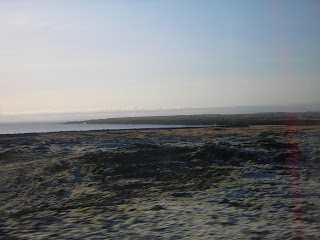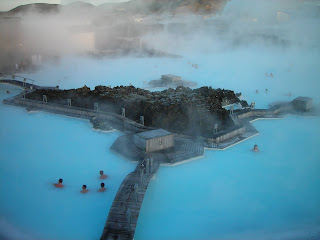Ég hef gengið á milli hrauna og lóna (I have walked among lava fields and lagoons)
This weekend my friends and I went on the first of this semester’s day-tours, to the remarkable peninsula called Reykjanes (Smoking Ness), about 45 minutes south of Reykajvík. At the end of this peninsula is the Keflavík international airport, so anyone taking the shuttle from the airport to the city has seen the eerie moonscape lava fields, but how often do you get to spend a whole day there? Saturday was our chance—and a perfect day we had for it, too, given that it was the first and only sunny day since the start of the term!

Our first stop as we drove down the peninsula was a little wooden church, built right on the shore in 1888 by a group of sailors who, during a terrible storm, pledged their word to found a church wherever they made landfall. They say a bright light guided them miraculously to this sheltered bay (thereafter called Engilsvík—Angel’s Bay), and they kept their word. In fact, despite its tiny size it is one of the wealthiest churches in Iceland because sailors continuously donate money to it. The caretaker, who had to have our guide translate for her, told us that they have a spotlight that they shine on the church at night, and if it goes out or they forget to turn it on, sailors actually radio in from the sea and complain that they can’t see their church. In a nation as lukewarmly religious as Iceland, I think that’s a lovely statement.

We continued a long way over Reykjanes, along the southern coastline, gaping at the lava formations all the way, and even though my camera doesn’t like taking pictures from a moving vehicle, I convinced it to give me a few shots that are more or less clear. The road, for part of the way, isn’t paved, and I actually got the best shots on those parts of the drive because it forced the bus to slow down. The fields that look like bizarre scenes from the ocean floor, covered with some 600 species of moss, are older than the rocky, jagged moonscape ones, but none of them are older than 10,000 years. If they were, they would have been smoothed and flattened by the glaciers of the last Ice Age.

The tour stopped at a geothermal area called Seltún too, a place similar to Geysir Park but without the spouting springs. It does, however, have all the Martian-looking red and white clay, plus bubbling mud pots and boiling rivers. Steam puffs from every crevice, even pits in the trail itself, and the chemicals turn the water a shade of denim-dye blue. At one point scientists had drilled an experimental hole into the surface, from which steam rose for years. Then one day, it stopped. And a few years ago, without any warning, it exploded, destroying the concrete facility around the hole and flattening the hut of the caretaker. Fortunately, no one was around when this happened.

Our last stop of the day was a much less hazardous geothermal area, the famed Blue Lagoon. The formation of the spring was actually a manmade accident, our guide told us: in building a power plant to harness the natural geothermal energy, water was diverted from a hot spring, and the designers assumed it would be absorbed into the porous lava field—but they were wrong. There is so much clay-like sediment in the water that it soon coated the lava and the water pooled into a huge natural hot tub. Well, it didn’t take long for this hot tub (plus the skin-friendly silt it collects) to attract a large tourist following, and after a couple of people drowned in the 70s, they evened out the bottom and built up a fancy state-of-the-art spa in the past decade or so. I expected the whole place to be quite tamed and organized, but even though the building itself is very sophisticated, the pool itself remains more or less in its natural state—some spots hotter than others, one spot even freezing over where the water runs out into the lava field.

I should note that I didn’t go swimming because spas are rather pricey and I know I’ll be going again on other occasions, but I’m told that it was a lovely time, even though the air was only 25 degrees! For my own part, I explored the area outside the building with a couple other friends who weren’t feeling aquatic. Now, when I hear the word “lagoon,” I start thinking of parrots and pirates and Kokomo. I was not prepared to find this area a breathtaking Arctic wonderland of milky blue water the exact same color as the sky, surrounded by vast lava fields coated in sparkling frost!

The lava field surrounding the Blue Lagoon is called Illahraun—the Evil Lava Field, undoubtedly because it would be impassable had the road not been leveled out and paved by an inconceivable amount of work. (The sagas tell stories of berserkers being roped into clearing paths through lava fields because they were the only ones hearty enough to manage it!) But standing there, in the dead quiet of a winter afternoon, it did not feel evil. It was magic.
